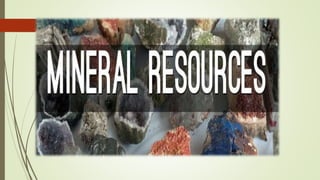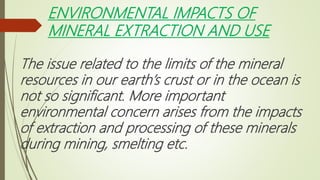Mineral resources
- 1. MINERAL RESOURCES ÔÇ¥Made by :- MOHD SAMEER ÔÇ¥Class :- B-PHARM [SFS] 2nd sem. ÔÇ¥ subject :- ENVIROMENTAL SCIENCES
- 3. What are mineral resources ? Minerals are naturally occurring, inorganic, crystalline solids having a definite chemical composition and characteristic physical properties. They are finite, non-renewable deposits and include metals (e.g. iron, copper, and aluminium ), and non-metals (e.g. salt, gypsum, clay, sand, phosphates).
- 4. There are thousands of minerals occurring in different parts of the world. most of these contain inorganic compounds formed by various combinations of the eight elements (O, Si, Al, Fe, Ca , Na, K, and Mg) that make up 98.5% of the Earth’s crust. Constitute the vital raw materials for many basic industries and are a major resource for development.
- 5. TYPES OF MINERAL RESOURCES FUEL MINERALS Coal: we are a good reservoirs for coal and nearby 400 tones are mined annually. Oil(petroleum): It is believed that petroleum has been formed over a period of millions of years, through conversion of remains of micro organisms living in sea, into hydrocarbon by heat, pressure and catalytic action. The petroleum on fractional distillation and further processing provides us numerous products and by-products.
- 6. Natural gas: The proven reserve for natural gas on April 1993 works out to be approx. 700 billion cubic meter (BCM). As regard to production vis a utilization aspect in earlier years, more than half of gas coming out of the wells remained unutilized. However, in recent years, we have achieved a utilization rate of 80 – 90% and it is unlikely that our gas reserves might last for more than 20 years.
- 8. METALLIC MINERALS Hard substance and conduct heat and electricity with a characteristics of luster or shine. They contains metals in their chemical composition and are potential source of the metal that can be got through mining. Example: Gold, Silver, Tin, Copper, Lead, Zinc, Iron, Nickel, Chromium, and Aluminum. NONMETALLIC MINERALS A non-metallic shine or lustre in their appearance. Do not contain extractable metals in their chemical composition. No new product can be generated if they are melted. Example: sand, gravel, gypsum, halite, Uranium, dimension stone.
- 10. USES OF MINERAL RESOURCES ÔÇ¥ Development of industrial plants and machinery. ÔÇ¥Generation of energy e.g. coal, lignite, uranium. ÔÇ¥ Construction, housing, settlements. ÔÇ¥ Defense equipments - weapons, armaments. ÔÇ¥ Transportation means.
- 11. ÔÇ¥ Communication- telephone wires, cables, electronic devices. ÔÇ¥ Medicinal system- particularly in Ayurvedic System. ÔÇ¥ Formation of alloys for various purposes (e.g. phosphorite). ÔÇ¥ Agriculture. as fertilizers, seed dressings and fungicides (e.g. zineb containing zinc, Maneb- containing manganese etc.). ÔÇ¥ Jewellery e.g. Gold, silver, platinum, diamond.
- 14. SOME MAJOR MINERALS OF INDIA ÔÇ¥ Energy generating minerals Coal and lignite: West Bengal, Jharkhand, Orissa, M.P ., A.P . Uranium (Pitchblende or Uranite ore): Jharkhand, Andhra Pradesh (Nellore, Nalgonda), Meghalaya, Rajasthan (Ajmer).
- 15. SOME MAJOR MINERALS OF INDIA ÔÇ¥ Other commercially used minerals: ÔÇ¥ Aluminium (Bauxite ore): Jharkhand, West Bengal, Maharashtra, M.P ., Tamilnadu. ÔÇ¥ Iron (haematite and magnetite ore): Jharkhand, Orissa, M.P ., A.P ., Tamilnadu, Karnataka, Maharashtra and Goa. ÔÇ¥ Copper (Copper Pyrites): Rajasthan (Khetri), Bihar, Jharkhand, Karnataka, M.P ., West Bengal, Andhra Pradesh and Uttaranchal.
- 16. ENVIRONMENTAL IMPACTS OF MINERAL EXTRACTION AND USE The issue related to the limits of the mineral resources in our earth’s crust or in the ocean is not so significant. More important environmental concern arises from the impacts of extraction and processing of these minerals during mining, smelting etc.
- 17. ÔÇ¥Jharia coal mines, Jharkhand: underground fire leading to land subsidence and forced displacement of people. ÔÇ¥ Sukinda chromite mines, Orissa: seeping of hexavalent chromium into river posing serious health hazard, Cr6+ being highly toxic and carcinogenic. ÔÇ¥ Kudremukh iron ore mine, Karnataka: causing river pollution and threat to biodiversity.
- 18. ÔÇ¥East coast Bauxite mine, Orissa: Land encroachment and issue of rehabilitation unsettled. ÔÇ¥ North-Eastern Coal Fields, Assam: Very high sulphur contamination of groundwater. ÔÇ¥ Jaduguda Uranium Mine, Jharkhand: exposing exposing local people to radioactive hazards.
- 19. IMPACTS OF MINING ÔÇ¥Mining is done to extract minerals (or fossil fuels) from deep deposits in soil by using sub-surface mining or from shallow deposits by surface mining. ÔÇ¥The former method is more destructive, dangerous and expensive including risks of occupational hazards and accidents.
- 20. Surface mining can make use of any of the following three types: ÔÇ¥ Open-pit mining in which machines dig holes and remove the ores (e.g. copper, iron, gravel, limestone, sandstone, marble, granite). ÔÇ¥ Dredging in which chained buckets and draglines are used which scrap up the minerals from under-water mineral deposits. ÔÇ¥ Strip mining in which the ore is stripped off by using bulldozers, power shovels and stripping wheels (e.g. phosphate rocks).
- 21. THE ENVIRONMENTAL DAMAGE CAUSED BY MINING ACTIVITIES ÔÇ¥De-vegetation and defacing of landscape: The topsoil as well as the vegetation are removed from the mining area to get access to the deposit. While large scale deforestation or de-vegetation leads to several ecological losses. The landscape also gets badly affected. The huge quantities of debris and tailings along with big scars and disruptions spoil the aesthetic value of the region and make it prone to soil erosion. ÔÇ¥Subsidence of land: This is mainly associated with underground mining. Subsidence of mining areas often results in tilting of buildings, cracks in houses, buckling of roads, bending of rail tracks and leaking of gas from cracked pipelines leading to serious disasters.
- 22. ÔÇ¥Groundwater contamination: Mining disturbs the natural hydrological processes and also pollutes the groundwater. Sulphur, usually present as an impurity in many ores is known to get converted into sulphuric acid through microbial action, thereby making the water acidic. Some heavy metals also get into the groundwater and contaminate it posing health hazards. ÔÇ¥ Surface water pollution: The acid mine drainage often contaminates the nearby streams and lakes. The acidic water is detrimental to many forms of aquatic life. Sometimes radioactive substances like uranium also contaminate the water bodies through mine wastes and kill aquatic animals. Heavy metal pollution of water bodies near the mining areas is a common feature creating health hazards.
- 23. ÔÇ¥ Air pollution: In order to separate and purify the metal from other impurities in the ore, smelting is done which emits quantities of air pollutants damaging the vegetation nearby has serious environmental health impacts. The suspended particulate matter (SPM), SOx, soot, arsenic particles, cadmium, lead etc. shoot up in the atmosphere near the smelters and the public suffers from several health problems. ÔÇ¥Occupational Health Hazards: Most of the miners suffer from various respiratory and skin diseases due to constant exposure the suspended particulate matter and toxic substances. Miners working in different types of mines suffer from asbestosis, black lung disease etc.
- 24. CONSERVATION OF MINERAL RESOURCES ÔÇ¥Selection and adoption of suitable methodology of mining which will have negligible effect on environment. ÔÇ¥ Economic and optimum use of minerals. Low grade ores can be better utilised by microbial leaching technique. ÔÇ¥ Recovering all associated elements as co-products or by- products. ÔÇ¥ Use and reuse of scraps after suitable treatments. ÔÇ¥ Replacing rare and costly minerals with those which are abundant and cheaper. ÔÇ¥ Restoration of mineral areas by revegetation.
![MINERAL
RESOURCES
ÔÇ¥Made by :- MOHD SAMEER
ÔÇ¥Class :- B-PHARM [SFS] 2nd sem.
ÔÇ¥ subject :- ENVIROMENTAL
SCIENCES](https://image.slidesharecdn.com/mineralresourcesmohdsameersfs2ndsem-210613110208/85/Mineral-resources-1-320.jpg)























